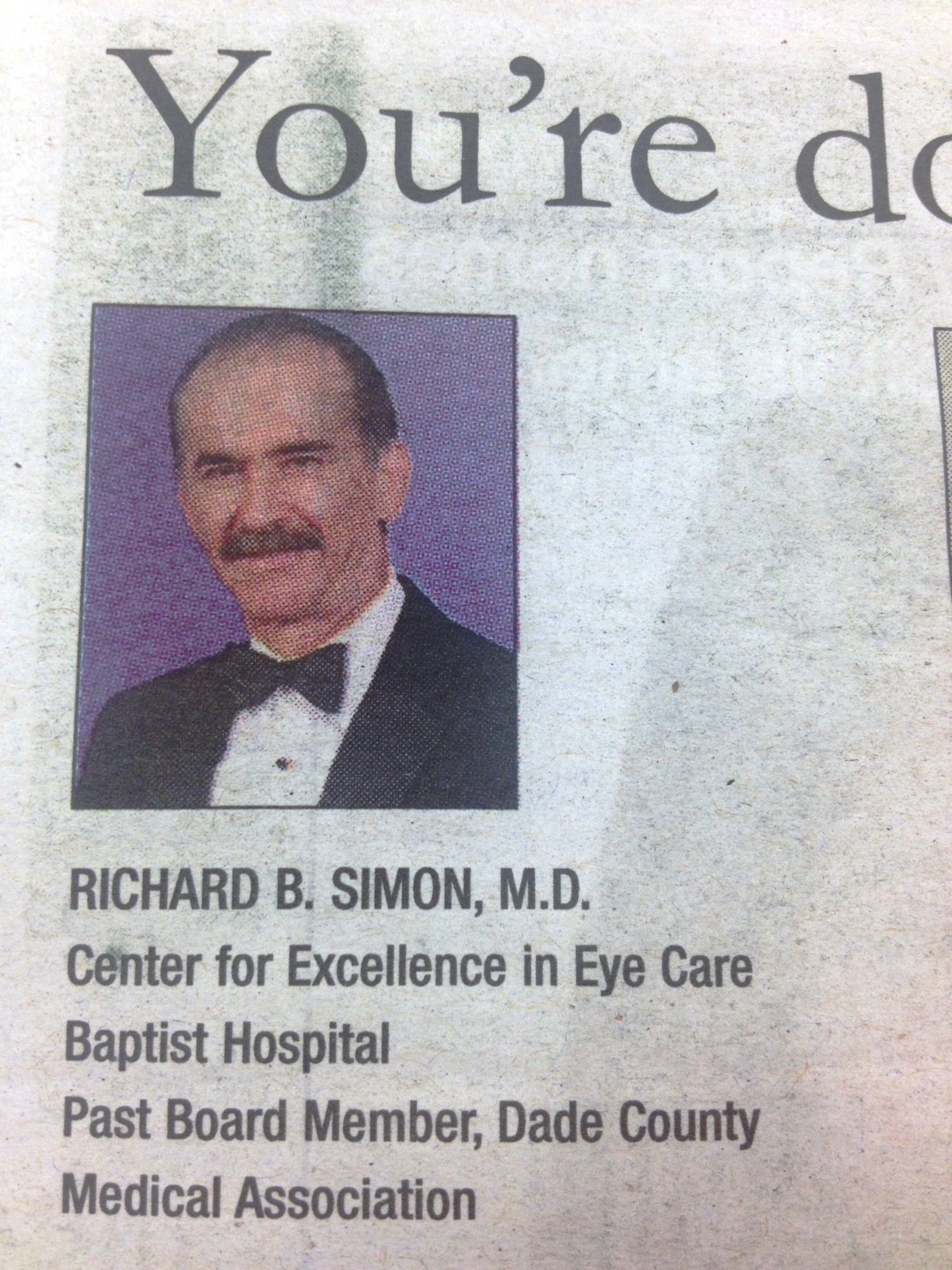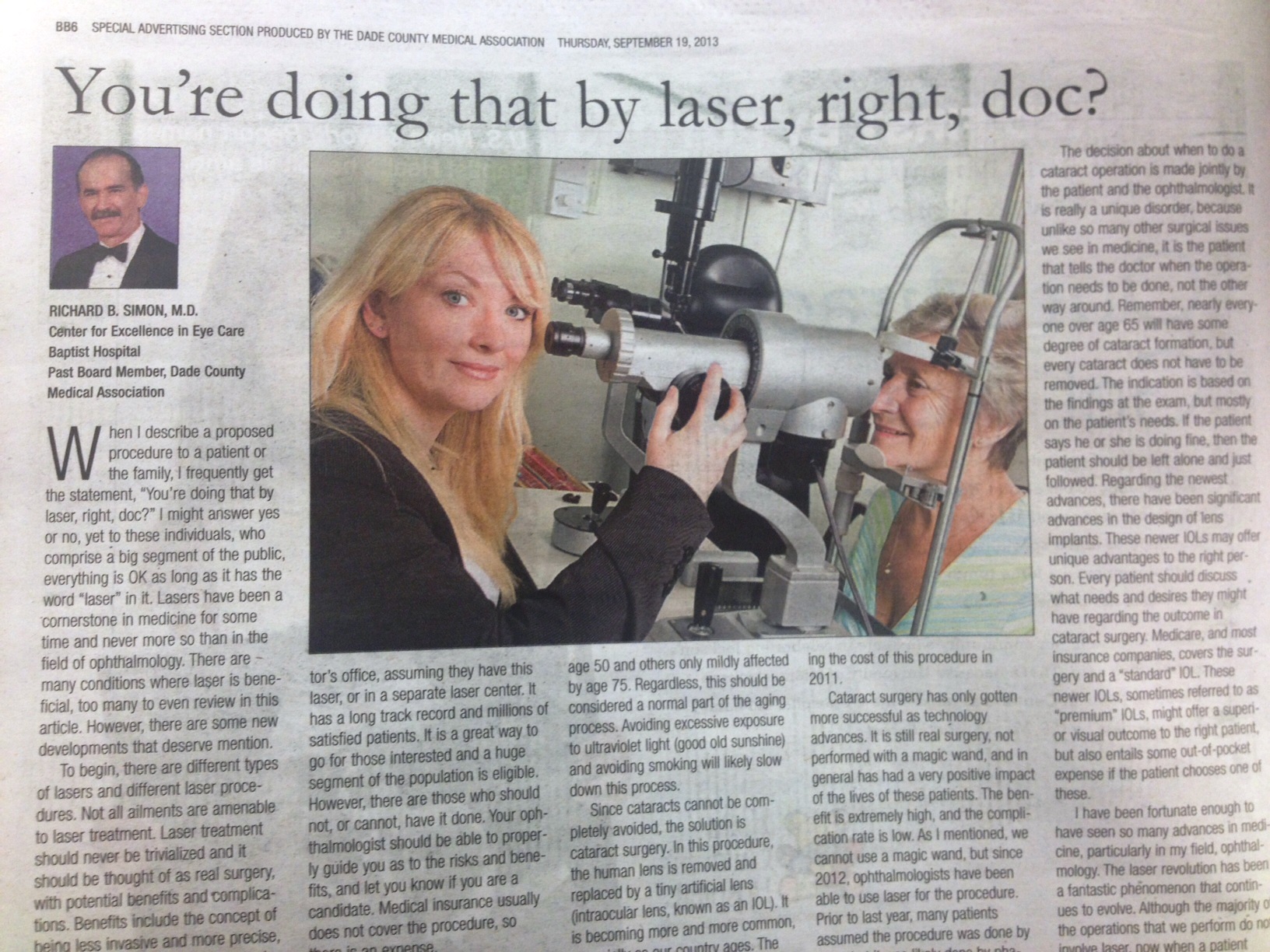LASIK and Laser Cataract Article by Dr. Richard Simon is featured in the Miami Herald
Our very own Dr. Richard Simon’s article about LASIK and LASER CATARACT SURGERY was featured in the Miami Herald last week! Dr. Simon explains the technological advancements in both LASIK/refractive surgery as well as cataract surgery, and how lasers have played into the equation. Please scroll down to see the article in its entirety.

You’re doing that by laser, right, doc?
By Dr. Richard B. Simon, M.D.
Center for Excellence in Eye Care
Baptist Hospital
Past Board Member, Dade County Medical Association
When I describe a proposed procedure to a patient or the family, I frequently get the statement, “You’re doing that by laser, right, doc?” I might answer yes or no, yet to these individuals, who comprise a big segment of the public, everything is OK as long as it has the word “laser” in it. Lasers have been a cornerstone in medicine for some time and never more so than in the field of ophthalmology. There are many conditions where laser is beneficial, too many to even review in this article. However, there are some new developments that deserve mention.
To begin, there are different types of lasers and different laser procedures. Not all ailments are amenable to laser treatment. Laser treatment should never be trivialized and it should be thought of as real surgery, with potential benefits and complications. Benefits include the concept of being less invasive and more precise, and faster healing. There are two significant and growing uses of laser.
This first is the excimer laser that is used for treatment of nearsightedness (myopia), farsightedness (hyperopia), and astigmatism. The procedure most commonly used is LASIK, and its alternatives, usually referred to as PRK or LASEK. These are basically variations of the same procedure, with notable differences, but yield the same result. Generally speaking, this procedure is designed for those who have worn glasses (or contact lenses) most of their lives and are looking for a safe, reliable and predictable alternative. It is usually done in the doctor’s office, assuming they have this laser, or in a separate laser center. It has a long track record and millions of satisfied patients. It is a great way to go for those interested and a huge segment of the population is eligible. However, there are those who should not, or cannot , have it done. Your ophthalmologist should be able to properly guide you as to the risks and benefits, and let you know if you are a candidate. Medical insurance usually does not cover the procedure, so there is an expense.
The second new and exciting application for laser is in cataract surgery. Everyone knows what a blessing good eyesight is and how important that precious sense is, especially as we age. Like so many things in life, we have a tendency to take things for granted, and only become aware of something after it is taken away. Cataract formation, a normal darkening and deterioration of the lens inside the eye, will happen to everyone with time. This causes a progressive loss of vision, very subtle initially, but if left untreated, will cause significant loss of sight. Some are in real trouble by age 50 and others only mildly affected by age 75. Regardless, this should be considered a normal part of the aging process. Avoiding excessive exposure to ultraviolet light (good old sunshine) and avoiding smoking will likely slow down this process.
Since cataracts cannot be completely avoided, the solution is cataract surgery. In this procedure, the human lens is removed and replaced by a tiny artificial lens (intraocular lens, known as an IOL). It is becoming more and more common, especially as our country ages. The American Academy of Ophthalmology notes that 20.5 million Americans have some degree of cataract formation. Half of the population over age 80 has a visually significant cataract and has trouble with the activities of daily life. Our nation is getting older, and in 2011, 40 million Americans were over 65 years of age. The impact of cataract surgery is not to be taken lightly, since more than 1.5 million cataract operations were done last year in the USA. The federal government, through the Medicare program, spent $3.4 billion dollars covering the cost of this procedure in 2011.
Cataract surgery has only gotten more successful as technology advances. It is still real surgery, not performed with a magic wand, and in general has had a very positive impact of the lives of these patients. The benefit is extremely high, and the complication rate is low. As I mentioned, we cannot use a magic wand, but since 2012, ophthalmologists have been able to use laser for the procedure. Prior to last year, many patients assumed the procedure was done by laser, but it was likely done by phacoemulsification, a form of ultrasound with a vacuum. The femtosecond laser, first used in LASIK, now can be used in cataract surgery. The benefits include more precision and faster healing. Some important points: The laser should be considered a “laser assist,” since the entire procedure is not done by the laser, and phacoemulsification is still used. In addition, the procedure is usually packaged with a premium IOL (discussed in the next paragraph), so that there is some cost to the patient.
The decision about when to do a cataract operation is made jointly by the patient and the ophthalmologist. It is really a unique disorder, because unlike so many other surgical issues we see in medicine, it is the patient that tells the doctor when the operation needs to be done, not the other way around. Remember, nearly everyone over age 65 will have some degree of cataract formation, but every cataract does not have to be removed. The indication si based on the findings at the exam, but mostly on the patient’s needs. If the patient says he or she is doing fine, then the patient should be left alone and just followed. Regarding the newest advances, there have been significant advances in the design of lens implants. These newer IOLs may offer unique advantages to the right person. Every patient should discuss what needs and desires they might have regarding the outcome in cataract surgery. Medicare, and most insurance companies, covers the surgery and a “standard” IOL. These newer IOLs, sometimes referred to as “premium” IOLs, might offer a superior visual outcome to the right patient, but also entails some out-of-pocket expense if the patient chooses one of these.
I have been fortunate enough to have seen so many advances in medicine, particularly in my field, ophthalmology. The laser revolution has been a fantastic phenomenon that continues to evolve. Although the majority of the operations that we perform do not involve laser, now when a patient comments, “You’re doing that by laser, right, doc?” I can frequently answer “yes.” Your eyesight is a precious gift. Just talk to anyone who has lost vision and you will quickly realize that. Make sure you see an ophthalmologist regularly. It should certainly be yearly for those over 60. Hopefully with the advances in medical technology and greater understanding of visual disorders and diseases, we all can go through life, steamrolling into those golden years with the gift of good vision.









